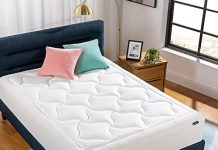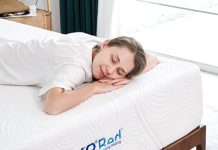Have you ever wondered how to clean and care for a floor mattress? Well, look no further! In this article, we will share some practical tips and tricks to ensure that your floor mattress stays fresh and hygienic for a comfortable night’s sleep. From tackling stains to eliminating odors, we’ve got you covered. So, let’s roll up our sleeves and discover the secrets to keeping your floor mattress in top-notch condition!
Review contents
Regular Cleaning
Vacuuming the mattress surface
Regularly vacuuming the surface of your mattress is an essential part of maintaining its cleanliness. Dust, dirt, and allergens can accumulate over time, so it’s important to use a vacuum cleaner with a brush attachment to remove these particles. Start by running the vacuum across the entire surface of the mattress, paying attention to any crevices or seams where debris may collect. Vacuuming once a month is generally sufficient, but if you or your family members suffer from allergies, you might consider doing it more frequently.
Spot cleaning spills and stains
Accidents happen, and spills or stains on your mattress are inevitable. When dealing with spills, the key is to act fast to prevent the liquid from seeping into the mattress and causing more damage. Start by blotting the stain with a clean cloth to absorb as much liquid as possible. Then, using a mild detergent mixed with warm water, gently blot the stain until it disappears. Avoid using harsh chemicals or excessive moisture, as this can damage the mattress. Finally, allow the spot to air dry completely before using the mattress again.
Deodorizing the mattress
Over time, mattresses can develop unpleasant odors. To keep your mattress smelling fresh, deodorizing it regularly is important. One easy and natural method is to sprinkle baking soda over the entire surface of the mattress. Baking soda is known for its ability to absorb odors. Leave the baking soda on the mattress for at least 30 minutes, allowing it to penetrate and neutralize any unwanted smells. Afterwards, simply vacuum up the baking soda with a brush attachment. Your mattress will be left smelling clean and fresh.
Deep Cleaning
Removing the mattress cover
Most mattresses come with removable covers that can be machine-washed. Start by carefully removing the cover according to the manufacturer’s instructions. Check for any stains or soiling on the cover as well, as these will need to be treated separately before washing.
Washing the mattress cover
Once the cover is removed, check the care label for specific washing instructions. In most cases, machine-washing the cover on a gentle cycle with mild detergent is recommended. Wash the cover separately from other items to prevent any damage. After the wash cycle is complete, air dry the cover or tumble dry it on a low heat setting. Avoid high heat as it can shrink or damage the cover. Once dry, replace the cover on the mattress.
Treating stubborn stains
For stubborn stains that haven’t been removed during regular spot cleaning, treating them directly can help. Create a solution by mixing equal amounts of water and white vinegar. Gently dab the solution onto the stain, being careful not to saturate the mattress. Allow the solution to sit for about 15 minutes before blotting it dry with a clean cloth. Repeat this process as necessary until the stain is no longer visible.
Sanitizing the mattress
To ensure your mattress is properly sanitized, you can use a fabric-safe disinfectant spray. Look for one that is specifically designed for mattresses and follow the instructions on the label. Lightly spray the entire surface of the mattress, focusing on areas that are frequently in contact with your body. Allow the disinfectant to dry completely before using the mattress again.
Drying the mattress cover
After washing the mattress cover, it’s important to ensure it is completely dry before putting it back on the mattress. Air drying is usually the best option as high heat can damage the cover. Hang the cover outdoors or in a well-ventilated area until it is fully dry. Once dry, make sure there is no moisture remaining before reattaching it to the mattress.
Storage and Maintenance
Storing the mattress properly
If you need to store your mattress for an extended period, it’s important to do so properly to prevent damage. Start by ensuring the mattress is clean and dry. Remove any bedding or mattress protectors and wrap the mattress in a breathable cover or plastic wrap. Avoid using sealed plastic bags, as they can trap moisture and promote mold or mildew growth. Store the mattress in a dry, cool, and well-ventilated area to maintain its quality during storage.
Regularly rotating the mattress
To extend the lifespan of your mattress and prevent uneven wear, it’s recommended to regularly rotate it. This means flipping the entire mattress 180 degrees and also rotating it from head to foot. The frequency of rotation depends on the type of mattress you have, so refer to the manufacturer’s guidelines. Rotating the mattress every three to six months is a good general rule to follow.
Using a mattress protector
To protect your mattress from spills, stains, and allergens, using a mattress protector is highly beneficial. Mattress protectors create a barrier between your body and the mattress, preventing sweat, dead skin cells, and dust mites from penetrating the surface. Choose a protector that is waterproof and breathable, and make sure it fits your mattress snugly. Washing the protector regularly will help maintain its effectiveness.
Avoiding jumping or bouncing on the mattress
While it may be tempting to jump or bounce on your mattress, it’s important to avoid doing so. Excessive force can damage the springs or foam inside the mattress, leading to sagging or indentation. Additionally, jumping on the mattress can void the warranty provided by the manufacturer. Instead, use your mattress for its intended purpose: a comfortable and supportive surface for sleeping and relaxing.
Bad Odor Removal
Sprinkling baking soda on the mattress surface
When faced with unpleasant odors on your mattress, baking soda once again comes to the rescue. Sprinkle a generous amount of baking soda evenly across the entire surface of the mattress. Baking soda is a natural deodorizer that can neutralize odors effectively.
Letting the baking soda sit
After sprinkling baking soda on the mattress, allow it to sit for several hours or even overnight. This will give the baking soda enough time to absorb the odors and freshen up the mattress.
Vacuuming the baking soda off the mattress
Once the baking soda has had time to work its magic, use your vacuum cleaner with a brush attachment to thoroughly vacuum the entire surface of the mattress. Make sure to remove all traces of the baking soda, as leaving it behind can cause discomfort while sleeping and may irritate the skin.
Preventing Dust Mites
Using an allergen-proof mattress cover
Dust mites are microscopic creatures that thrive in mattresses, feeding on dead skin cells. To prevent dust mites from infesting your mattress, invest in an allergen-proof mattress cover. These covers have a tightly woven fabric that acts as a barrier, preventing dust mites and other allergens from penetrating the mattress.
Washing bedding regularly at high temperatures
Dust mites also thrive in bedding, so it’s important to wash your sheets, pillowcases, and other bedding regularly. Use hot water and a detergent that is effective against dust mites. Hot water helps kill the mites and removes any allergens they may have left behind.
Vacuuming the mattress frequently
Regularly vacuuming your mattress is key to removing dust mites and their allergens. Use a vacuum cleaner with a HEPA filter to ensure that the mites and their allergens are trapped inside the vacuum and not released back into the air. Focus on areas where dust mites are most likely to accumulate, such as seams and crevices.
Avoiding eating on the mattress
Eating in bed may be comfortable, but it can also attract dust mites. Crumbs, food particles, and spills provide a feeding ground for these pests. By avoiding eating on the mattress, you can minimize the risk of dust mite infestations and keep your sleeping environment clean and healthy.
Removing Pet Hair
Using a lint roller or tape
If you share your bed with a furry friend, you’re likely familiar with the struggle of pet hair on your mattress. One easy way to remove pet hair is by using a lint roller or tape. Simply roll the lint roller or wrap the tape around your hand and pat it gently over the surface of the mattress. The sticky surface will catch and lift the pet hair.
Using a pet hair vacuum attachment
Another effective method for removing pet hair is using a vacuum cleaner with a pet hair attachment. This attachment typically has rubber bristles or a specially designed brush that grabs and lifts pet hair from the mattress surface. Run the vacuum attachment over the mattress, making sure to cover the entire surface.
Brushing the mattress with a rubber glove or brush
If you don’t have a lint roller or vacuum attachment, a simple rubber glove or brush can be just as effective in removing pet hair. Put on a clean rubber glove or use a brush with soft bristles and lightly brush the mattress surface in a sweeping motion. The static electricity created will attract the pet hair, making it easier to collect.
Tackling Mold and Mildew
Removing any visible mold or mildew
Mold and mildew can be a serious issue if left unaddressed. If you notice any visible mold or mildew on your mattress, it’s important to act quickly. Start by wearing gloves and a mask to protect yourself from spores. Use a soft brush or cloth to gently remove the visible mold or mildew, taking care not to spread it further.
Applying a bleach solution
After removing the visible mold or mildew, it’s crucial to disinfect the affected area. Mix one part bleach with ten parts water to create a bleach solution. Dab the solution onto the affected area using a clean cloth or sponge. Make sure not to over-saturate the mattress and allow the solution to sit for about 15 minutes before proceeding.
Letting the mattress dry completely
Once the bleach solution has done its job, it’s important to let the mattress dry completely. Open windows or use fans to increase airflow and speed up the drying process. Make sure the mattress is thoroughly dry before using it again, as moisture can lead to the growth of mold and mildew.
Using a mattress protector to prevent future mold growth
To prevent future mold and mildew growth on your mattress, using a waterproof and breathable mattress protector is highly recommended. These protectors create a barrier between the mattress and any moisture, reducing the risk of mold and mildew thriving. Avoid placing the mattress directly on the floor, as this can trap moisture and increase the chances of mold growth.
Repairing Minor Damages
Patching small holes or tears
Over time, mattresses can develop small holes or tears in the fabric. These can be easily patched to prevent further damage. Start by cleaning the damaged area with a mild detergent and water. Allow the area to dry completely. Then, cut a piece of fabric slightly larger than the hole or tear and apply fabric glue or adhesive around the edges. Press the patch firmly onto the damaged area and let it dry according to the product instructions.
Using fabric glue or adhesive
Fabric glue or adhesive can also be used to repair any loose seams or detached parts of the mattress cover. Apply a small amount of glue or adhesive to the area that needs repairing, making sure to follow the manufacturer’s instructions. Press the damaged parts together firmly and hold them in place until the glue or adhesive sets.
Replacing damaged mattress covers
If the damage to the mattress cover is beyond repair or if you simply want to freshen up your mattress, consider replacing the cover altogether. Measure the dimensions of your mattress and purchase a new cover that fits properly. Follow the manufacturer’s instructions on how to attach the new cover to your mattress.
Repairing sagging or indentation
Sagging or indentation in a mattress can affect its comfort and support. While minor sagging can often be resolved by rotating or flipping the mattress, more severe cases may require additional measures. Adding a mattress topper or using a support system, such as a bunkie board or plywood, can help alleviate sagging and prolong the life of your mattress.
Tips for Everyday Care
Avoiding eating or drinking on the mattress
As tempting as it may be to enjoy a snack or a drink in bed, it’s best to avoid doing so. Accidental spills can cause stains and attract pests, while crumbs can attract dust mites. Keeping the mattress free from food and drink will help maintain its cleanliness and prevent potential damage.
Keeping pets away from the mattress
While many of us enjoy cuddling with our pets, keeping them off the mattress is important for its cleanliness and longevity. Pet hair, dander, and dirt can accumulate on the mattress, leading to hygiene issues and potential allergens. Encourage your pets to have their own designated sleeping area to minimize their contact with the mattress.
Ensuring the mattress is properly supported
To maintain the integrity of your mattress and prevent premature wear, it’s crucial to ensure it is properly supported. Choose a bed frame or foundation that is designed to support the specific type and size of your mattress. Avoid using an old or damaged frame that may compromise the structural integrity of the mattress.
Using a mattress topper for extra protection
A mattress topper can offer an additional layer of protection for your mattress. Not only does it provide extra comfort, but it also acts as a barrier between you and the mattress. This can help prevent stains, spills, and odor penetration, making cleaning and maintenance easier in the long run.
Professional Cleaning Services
Hiring a professional mattress cleaning service
If you prefer to leave the cleaning and maintenance of your mattress to the professionals, hiring a professional mattress cleaning service is a great option. These services have the expertise and specialized equipment to thoroughly clean and sanitize your mattress, ensuring its longevity and hygiene. They can also offer additional treatments, such as stain removal or odor elimination.
Considering steam cleaning
Steam cleaning is an effective method for deep cleaning and sanitizing mattresses. It uses high-temperature steam to kill dust mites, germs, and bacteria, while also removing stains and odors. However, it’s important to check the manufacturer’s recommendations before using steam cleaning, as certain types of mattresses may not be suitable for this method.
Checking for mattress manufacturer’s recommendations
Every mattress is unique, and it’s important to check the manufacturer’s recommendations for cleaning and care. Some mattresses may require specific cleaning methods or have warranty conditions that need to be followed. By adhering to the manufacturer’s guidelines, you can ensure that your mattress remains in optimal condition and that you don’t inadvertently void any warranties.
In conclusion, regular cleaning and maintenance are vital for keeping your floor mattress clean, fresh, and hygienic. By following the tips and methods outlined in this article, you can tackle various cleaning challenges, prevent common issues, and extend the lifespan of your mattress. Whether it’s simple vacuuming, deep cleaning, or addressing specific concerns like pet hair or mold, there are effective solutions to keep your floor mattress in top shape. Remember to prioritize proper storage, regular rotation, and the use of mattress protectors for continued care. Should you prefer professional assistance, there are services available to provide deep cleaning and steam cleaning. By providing the necessary care and attention, you can enjoy a clean and comfortable floor mattress for years to come.



























